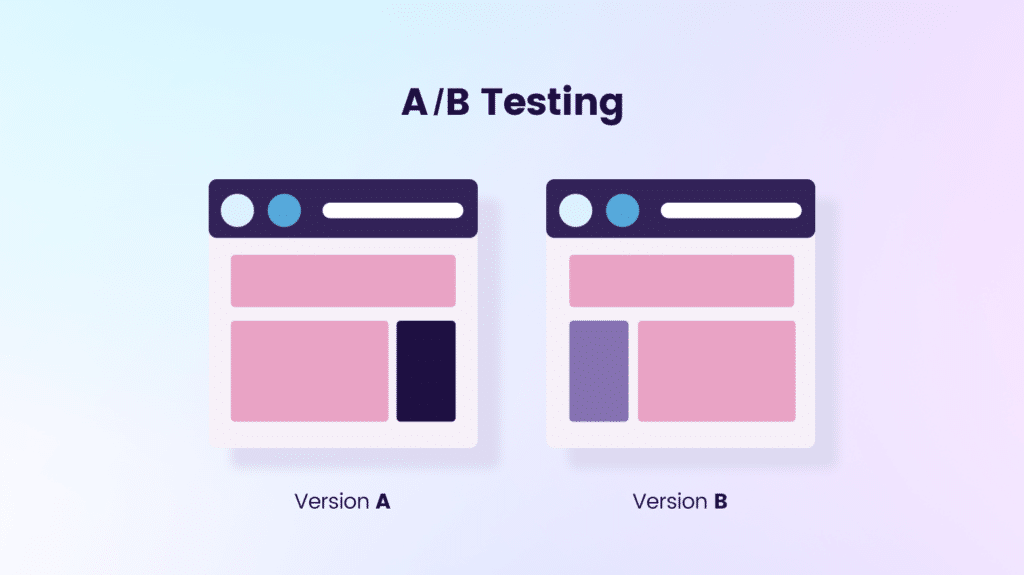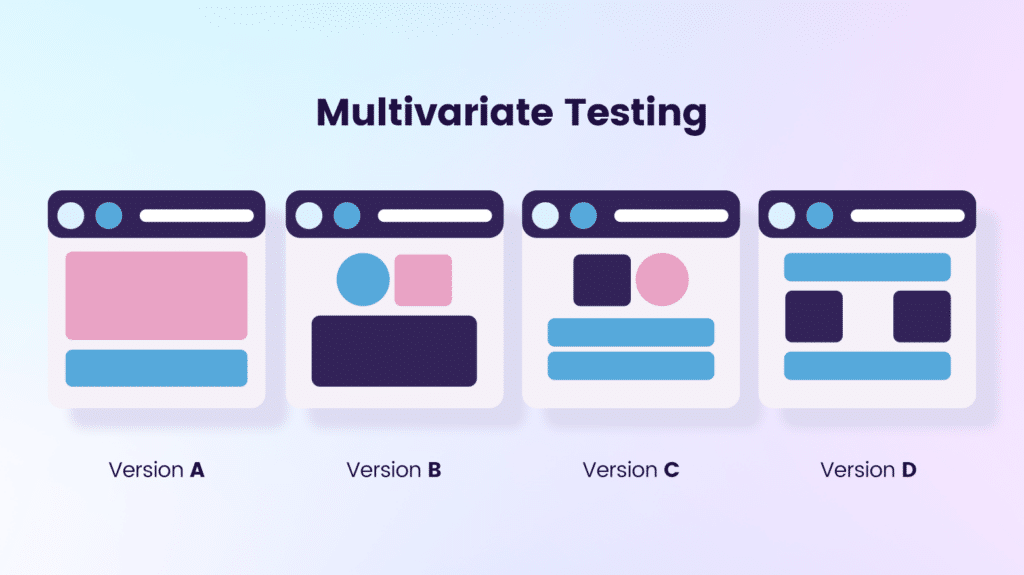Testing is more than just a good practice in website optimization—it’s a cornerstone of success. Here, we discuss two testing methodologies: A/B Testing and Multivariate Testing.
Each of these approaches offers unique insights into how changes on your site can impact user behavior and conversion rates.
Understanding and choosing the right testing approach is crucial for effective website optimization. Let’s explore what these tests entail and how they can significantly enhance your website’s performance.
What is A/B Testing
A/B Testing is a straightforward method used in website optimization. It involves comparing two versions of a webpage: Version A (the control) and Version B (the variation). The key here is that Version B has one specific change from Version A, which could be anything from a different headline to a new button color.
Traffic to your website is evenly split between these two versions to see which performs better based on your chosen metrics, such as user engagement or conversion rates.
When to use A/B Testing
A/B Testing can be incredibly versatile. Here are five scenarios where it is effective:
-
Pricing Experiments
Test different pricing models or display formats on your product pages. For instance, you might compare a straight price against a ‘monthly installment’ price to see which is more appealing to your customers.
-
Urgency Messaging for Limited-Stock Products
Online retailers often use urgency messaging to entice hesitant buyers to make quick decisions. A/B tests whether displaying an exact stock count (“Only 3 left in stock!”) performs better than a more general urgency statement (“Selling fast! Don’t miss out!”). The test can reveal whether customers respond more strongly to numerical scarcity or general urgency, helping fine-tune messaging for higher conversions.
-
Trust Signals in Checkout Forms
Checkout drop-offs can be influenced by security concerns or a lack of reassurance. A/B test whether adding a trust badge (e.g., “100% Secure Payment—Verified by Stripe“) versus displaying customer testimonials near the payment form increases completion rates. If trust signals increase conversions, they can be strategically placed throughout the checkout process to reinforce credibility.
-
Out-of-Stock Handling
When products go out of stock, customers may leave the site instead of exploring alternatives. Test whether a “Notify Me When Available” option (which captures emails for future restocks) performs better than “Here Are Similar Items You Might Like” (which directs users to alternative products). If the alternative product recommendation results in more immediate purchases, it suggests that customers prefer finding a substitute rather than waiting.
Advantages of A/B Testing over Multivariate Testing
While both A/B Testing and Multivariate Testing are valuable tools in website optimization, A/B Testing has specific advantages that make it more suitable in certain scenarios:
-
Simplicity and Ease of Implementation
A/B Testing is generally more straightforward to set up and execute than Multivariate Testing. It involves testing a single variable, making tracking changes, and analyzing results.
-
Lower Traffic Requirements
A/B Tests are effective even with relatively lower website traffic, making them suitable for smaller websites or those just starting to explore optimization strategies.
-
Faster Results
Due to its simplicity and the testing of fewer variations, A/B Testing often leads to quicker results, which allows for faster decision-making and implementation of changes.
-
Clearer Insights into Specific Changes
A/B Testing provides more precise insights into how specific changes impact user behavior by focusing on one variable at a time, which can be helpful when testing significant changes or new features.
-
Less Risk of Interaction Effects
A/B Testing eliminates the complexity of interaction effects between multiple variables, which can be challenging in Multivariate Testing. This makes it easier to attribute outcomes directly to the changes made.
-
Better Suitability for Fundamental Changes
When testing fundamental changes, such as a complete redesign of a landing page or major shifts in content strategy, A/B Testing can be more effective in isolating the impact of these significant changes.
-
Resource Efficiency
A/B Testing can be less resource-intensive in terms of both the time and technical expertise required for setup, analysis, and interpretation of results.
Limitations of A/B Testing
While A/B Testing is a powerful tool for website optimization, it does have certain limitations that are important to consider:
-
Limited to Single Variable Testing
A/B Testing focuses on comparing two versions of a page with only one differing element. This limitation means it can’t simultaneously measure the impact of multiple variables or their interactions.
-
Potential for Misleading Results Due to External Factors
External factors like seasonal trends, market changes, or even temporary user behavior shifts can influence the results of an A/B test, which can sometimes lead to conclusions that aren’t applicable in the long term.
-
Not Ideal for Complex Interaction Analysis
A/B Testing is not designed to analyze how different elements on a page interact. If you aim to understand complex interactions between multiple-page elements, A/B Testing might not provide the depth of insight needed.
-
Time-Consuming for Sequential Testing
If you need to test multiple variables, A/B Testing requires sequential tests, which can be time-consuming. Each variable needs its test, extending the overall time frame for comprehensive optimization.
-
Risk of ‘Local Maximum’ Problem
A/B Testing is great for incremental improvements but can sometimes lead to a ‘local maximum’ issue, where the optimization focuses on improving the current design without considering radically different and potentially more effective designs.
What is Multivariate Testing
Multivariate Testing (MVT) is a method used in website optimization where multiple variables on a webpage are tested simultaneously to determine how they collectively influence user behavior and conversion rates.
Unlike A/B Testing, which compares two versions of a page with a single difference, MVT examines the impact of various combinations of changes to understand the best-performing version.
This approach is useful for analyzing how different elements on a page, such as headlines, images, and call-to-action buttons, interact and affect the overall user experience.
When to use Multivariate Testing
Multivariate Testing shines in scenarios where the relationship between multiple webpage elements is key to enhancing user experience and driving conversions. Here are five use cases for MVT:
-
Comprehensive Homepage Redesign
Multivariate testing can be invaluable in a complete overhaul of a website’s homepage. It allows you to experiment with various layouts, including the placement of banners, featured products, and navigation menus. The goal is to pinpoint the appealing layout and maximize user engagement and conversion rates.
-
E-commerce Product Page Optimization
For e-commerce sites, product page optimization is important. Using Multivariate Testing, you can test different arrangements of product images, descriptions, customer reviews, and add-to-cart buttons.
This approach helps identify which combination of these elements leads to better page performance, ultimately boosting sales.
-
Subscription Form Improvements
The design of the subscription form can make a big difference in increasing newsletter sign-ups or subscriptions.
Multivariate Testing allows you to try out various layouts, wordings, and designs for these forms to find the most effective one that resonates with your audience and encourages sign-ups.
-
Content and Media Interaction
Multivariate testing helps determine how different types of content, such as text, videos, and images, and their placement on a page affect user interaction. The objective is to optimize content placement to engage users more effectively, encouraging them to spend more time on the page.
-
CTA Button and Messaging Strategy
Pairing the right call-to-action (CTA) button with the most compelling marketing message is crucial. Multivariate Testing enables you to test various combinations of CTA button designs — considering aspects like color, size, and placement — along with different marketing messages. The aim is to discover which combination drives the most conversions or desired actions from users.
Advantages of Multivariate Testing over A/B Testing
Multivariate Testing offers several unique advantages over A/B Testing, particularly in scenarios requiring a deeper understanding of how multiple webpage elements interact. Here are some key benefits:
-
Comprehensive Analysis of Multiple Variables
Unlike A/B Testing, which focuses on the impact of a single change, Multivariate Testing allows for the simultaneous analysis of multiple variables. This provides a more holistic view of how different elements on a page work together, offering richer insights into user behavior and preferences.
-
Efficient Optimization of Complex Pages
Multivariate testing is more efficient for webpages with many interactive elements, such as e-commerce product pages or complex landing pages. It enables simultaneous testing of various components, speeding up the optimization process compared to the sequential approach required in A/B Testing.
-
Detailed Interaction Insights
Multivariate Testing excels in revealing how different elements on a page interact with each other. This is crucial for understanding the combined effect of changes and can lead to more effective overall page designs.
-
Higher Potential for Significant Improvements
Since Multivariate Testing explores a broader range of variations and interactions, it often uncovers opportunities for significant improvements that might be missed with the more singular focus of A/B Testing.
-
Optimization Beyond Surface-Level Changes
While A/B Testing is excellent for testing surface-level changes like colors or headlines, Multivariate Testing goes deeper, examining the impact of structural and complex changes, leading to more profound insights and impactful optimizations.
Limitations of Multivariate Testing
While Multivariate Testing offers in-depth insights for website optimization, it’s important to recognize its limitations. Here are some key constraints to keep in mind when considering Multivariate Testing for your website optimization strategies:
-
High Traffic Requirement
One of the primary limitations of Multivariate Testing is its need for a significant amount of traffic. Since the test involves multiple variations, a substantial traffic volume is required to achieve statistically significant results; this can be a major hurdle for websites with lower visitor numbers.
-
Complexity in Setup and Analysis
Multivariate Testing is more complex to set up and analyze than A/B Testing. Designing a test with multiple variables and then deciphering the interactions between these variables requires higher expertise and more sophisticated analysis tools.
-
Risk of Confounding Results
With multiple variables being tested simultaneously, there’s a risk that the effects of individual elements can become confounded. This means it can be challenging to pinpoint which specific element caused a change in user behavior.
-
Longer Duration for Conclusive Results
Due to the complexity and the need for more data, Multivariate Tests often take longer to run than A/B Tests. This longer duration can delay decision-making and the implementation of optimization strategies.
-
Potential Overwhelming of Users
Testing too many changes simultaneously can sometimes lead to an overwhelming user experience. If the variations are too drastic or numerous, gauging how each element performs in the user’s overall experience can be challenging.
Summary of A/B Testing vs Multivariate Testing
Understanding the fundamental differences between A/B Testing and Multivariate Testing is crucial for selecting the right approach for your website optimization needs.
Here’s a summary of their key differences based on various aspects:
|
Aspect |
A/B Testing |
Multivariate Testing |
|
Methodology |
Tests one variable at a time. |
Tests multiple variables simultaneously. |
|
Traffic Requirements |
Lower, suitable for sites with moderate to low traffic. |
Higher, needs significant traffic for statistical validity. |
|
Resource Requirements |
Less resource-intensive, simpler tools. |
More resource-intensive, advanced analytical tools are needed. |
|
Suitability |
Ideal for specific, isolated changes. |
Better for complex scenarios with interacting elements. |
|
Impact on Results |
Quick insights into single changes. |
Deeper understanding of multiple element interactions. |
|
Scalability and Flexibility |
More flexible and scalable. |
Less flexible, scaling up increases complexity. |
|
Risk and Reliability |
Lower risk, more predictable outcomes. |
Higher risk due to complex interactions. |
|
Data Quality and Accuracy |
Straightforward, clear-cut data. |
Richer data, but can be challenging to interpret. |
Conclusion
A/B Testing vs Multivariate Testing FAQs
How does an A/B Test differ from a Multivariate Test
A/B testing compares two versions of a single element or page to see which performs better, focusing on one change at a time—like testing two headlines or two different call-to-action buttons. Multivariate testing, on the other hand, looks at how multiple elements (such as headlines, images, and buttons) interact with one another by testing various combinations. This helps identify which combination of changes leads to the best outcome but requires more traffic to yield meaningful results.
Why would a brand use A/B testing rather than multivariate testing?
A brand might choose A/B testing when they want to test one change at a time for clarity, especially when there’s less traffic. It’s simpler to implement, requires less data, and is easier to interpret since only one variable is changed. In contrast, multivariate testing is more complex and best suited for websites with high traffic, as it needs more data to determine the impact of multiple elements.
What is an example of a multivariate test?
A multivariate test could be applied to a product landing page where you're testing different combinations of elements. For example, you might test two versions of a headline, three versions of an image, and two different calls to action. The test would analyze how these elements work together to find the best-performing combination, such as whether a specific headline paired with a certain image and button color leads to more conversions.
When to use multivariate testing?
Multivariate testing is most effective when you have a large amount of traffic and are looking to optimize multiple elements on a page. If you want to understand the combined effect of changing several elements at once—like the layout, text, images, and buttons—this approach is ideal. However, it’s best used when you’re confident that minor changes across multiple areas will improve performance and when you can afford the higher data requirements for accurate results.




